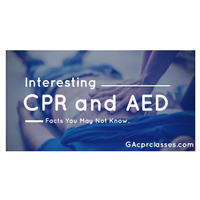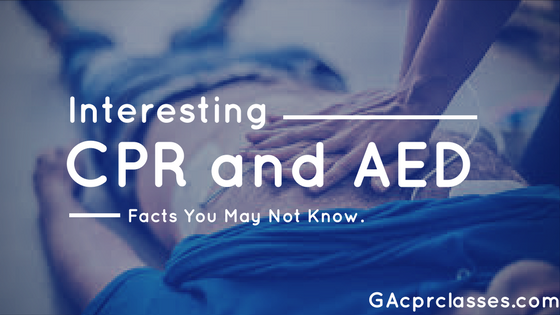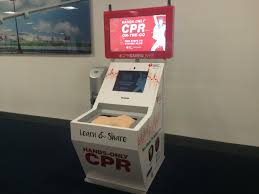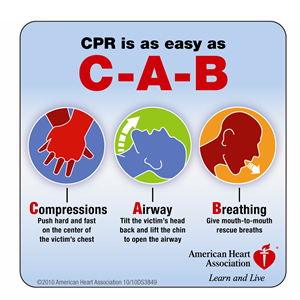Interesting CPR and AED Facts You May Not Know

[adinserter block=”2″]
[adinserter block=”3″]

Having to perform CPR is most likely to occur outside of a hospital and more than likely going to impact a loved one. Knowing what to do and when to start CPR and mean the difference between life and death.
CPR saves lives. Statistics show that the earlier CPR is initiated, the greater the chances for survival. It is estimated that 100,000 to 200,000 lives of adults and children could be saved each year if CPR were performed early enough, at the time of need.
If anyone collapses if front of you and is not breathing, call 911 and push hard and fast in the center of the chest until help or an AED arrives. If you find someone unresponsive and not breathing, get someone else to get help and begin chest compressions as fast as possible.
27 Interesting CPR and AED Facts You May Not Know
1. Heart Disease (including Coronary Heart Disease, Hypertension, and Stroke) remains to be the No. 1 cause of death in the US.
2. Cardiopulmonary Resuscitation (CPR) was developed in 1960. The American Heart Association (AHA) started a program to acquaint physicians with close-chest cardiac resuscitation that became the forerunner of CPR training for the general public.
3. For every minute after the heart has stopped, the patient loses 10% of their chance to survive. After ten minutes of waiting for paramedics, the person’s chances for survival are extremely poor.
4. The AHA says as many as 40,000 lives could be saved yearly with by having more Automated External Defibrillators (AEDs) available.

5. Without treatment, victims have only minutes to live. When First Aid, CPR and an AED are initiated, the survival rate can exceed 50%. AED’s drastically increases the chances of achieving Return Of Spontaneous Circulation (ROSC) versus CPR with just your hands alone.
6. If the necessary life-saving equipment and paramedics does not arrive in time, typical survival rates are less than 5%.
[adinserter block=”2″]
[adinserter block=”3″]
7. 70% of all out-of-hospital cardiac arrests happen at home.
8. 80% of what a paramedic does is defibrillation.
9. The AHA reports that brain damage can start to occur in just 4 – 6 minutes after the heart stops pumping blood.
10. AEDs should be brought to a patient’s side in less than 4 minutes. Response time should be calculated based on a moderately brisk walking speed of approximately 4 feet per second.
11. To meet a response time goal of 3 minutes, the defibrillator needs to be within 360 feet (90 seconds times 4 feet/second) of any given place.
12. Studies have shown that the need to climb stairs or use elevators can significantly slow response time. As a rule, for multi-story buildings, a minimum of one defibrillator per floor is recommended.
[adinserter block=”2″]
[adinserter block=”3″]
13. Only 46% of people who experience an out-of-hospital cardiac arrest receive the immediate care they need before professional help arrives and takes over.
14. Song examples that help with establishing the 100-120 compressions per minute rhythm include “Stayin’ Alive” by the Bee Gees, “Crazy in Love” by Beyoncé featuring Jay-Z, “Hips Don’t Lie” by Shakira” or “Walk the Line” by Johnny Cash. A pace of 2 compressions per second will get you into the appropriate rhythm as well.
15. The AHA has training simulators in select airports across the US. These machines teach hands only CPR, pushing to the rhythm of a classic disco song (Stayin’ Alive), and also provides feedback on the quality of chest compressions that were performed.

16. One in six men and one in eight women age 45 and over have experienced a heart attack or stroke.
17. Approximately 45% of all heart attacks occur in people under age 65.
18. CPR is not just for heart attacks. Approximately 7 million adults and children suffer injuries in their own homes and backyards each year, resulting in the need to begin CPR. Some causes of “sudden death” that may result in the need to start CPR: Electric Shock, Heart Attacks, Drowning, Severe Allergic Reactions, Choking, Drug Overdose (Poisoning), Suffocation, among others.
[adinserter block=”2″]
[adinserter block=”3″]
19. Cardiac arrest and heart attacks are often mistaken for each other. Heart attacks occur when blood flow to the heart is blocked and sudden cardiac arrest when the heart malfunctions and stop beating. Cardiac arrest is more of an electrical problem, while heart attacks are more circulation oriented. Heart attacks may also be the cause of cardiac arrest.
20. It is normal to break ribs while performing CPR. Think about it, you are pushing on the chest, in an unnatural motion, with a lot of effort and force. This is the only way to pump blood and get oxygen back to the brain, so breaking ribs is normal while performing chest compressions. A lot of paramedics will tell you that you are not doing CPR correctly if you don’t break any. Our philosophy is to give the person something to complain about. If they can talk about their ribs hurting, you helped save a life. Good Samaritan Laws should protect you in the occasion of injury.
21. The longest successful CPR save is 96 minutes long.
22. With 3 types of people that you may have to perform CPR to (Adults, Children, and Infants), Children are often the hardest to judge. There are a large number of children that look like adults and a large number of adults that still look like children. If you are ever confused, treat a child like adults in regards to First Aid and CPR.
23. AHA CPR certification cards are valid for 2 years. Unfortunately, CPR skills and knowledge begin to diminish in as little as 3 months due to lack of practice and discussion of critical concepts. This includes highly trained personnel like Doctors, Nurses, Dentists, Physicians, among others.
24. CPR was taught for a long time under the acronym A-B-C, Airway – Breathing – Chest Compressions. With recent guidelines changes, CPR is now taught C-A-B. Compressions are the most important step and should be started immediately if someone is unresponsive and not breathing.
[adinserter block=”2″]
[adinserter block=”3″]
25. 90% of people who suffer out-of hospital cardiac arrests do not survive. CPR, especially if performed immediately, can double or triple a cardiac arrest victim’s chance of survival.
26. The AHA does not have a minimum age requirement for people to learn CPR. The ability to perform CPR is based more on body strength compared to age. Studies have shown that children as young as 9 years old can learn and retain CPR skills.
27. CPR does not actually restart the heart. It allows the rescuer to manually pump blood and enable oxygen back to the brain to achieve ROSC (Return Of Spontaneous Circulation).

Sources: American Heart Association
- http://cpr.heart.org/AHAECC/CPRAndECC/AboutCPRFirstAid/CPRFactsAndStats/UCM_475748_CPR-Facts-and-Stats.jsp
- 2017 Hands Only CPR Fact Sheet: http://cpr.heart.org/idc/groups/ahaecc-public/@wcm/@ecc/documents/downloadable/ucm_493890.pdf
- Cardiac Arrest Statistics: http://cpr.heart.org/AHAECC/CPRAndECC/General/UCM_477263_Cardiac-Arrest-Statistics.jsp
Disclaimer: There are ads and affiliate links within our posts. We earn a small commission if you do choose to use the links and they do not add any additional cost to you if you do use them. Products are recommended because they are useful and helpful, not because of the commission possibly earned. Only use the links if you believe they can help you or you are interested in learning more about an advertisement.
3 Greater Atlanta offices, online and classroom options, and cards are issued at the time you complete training. ACLS, CPR, BLS, First Aid, and PALS classes are scheduled 7 days a week.
Click here to visit our website to learn more about our CPR classes: www.GAcprclasses.com
[adinserter block=”2″]
[adinserter block=”3″]
